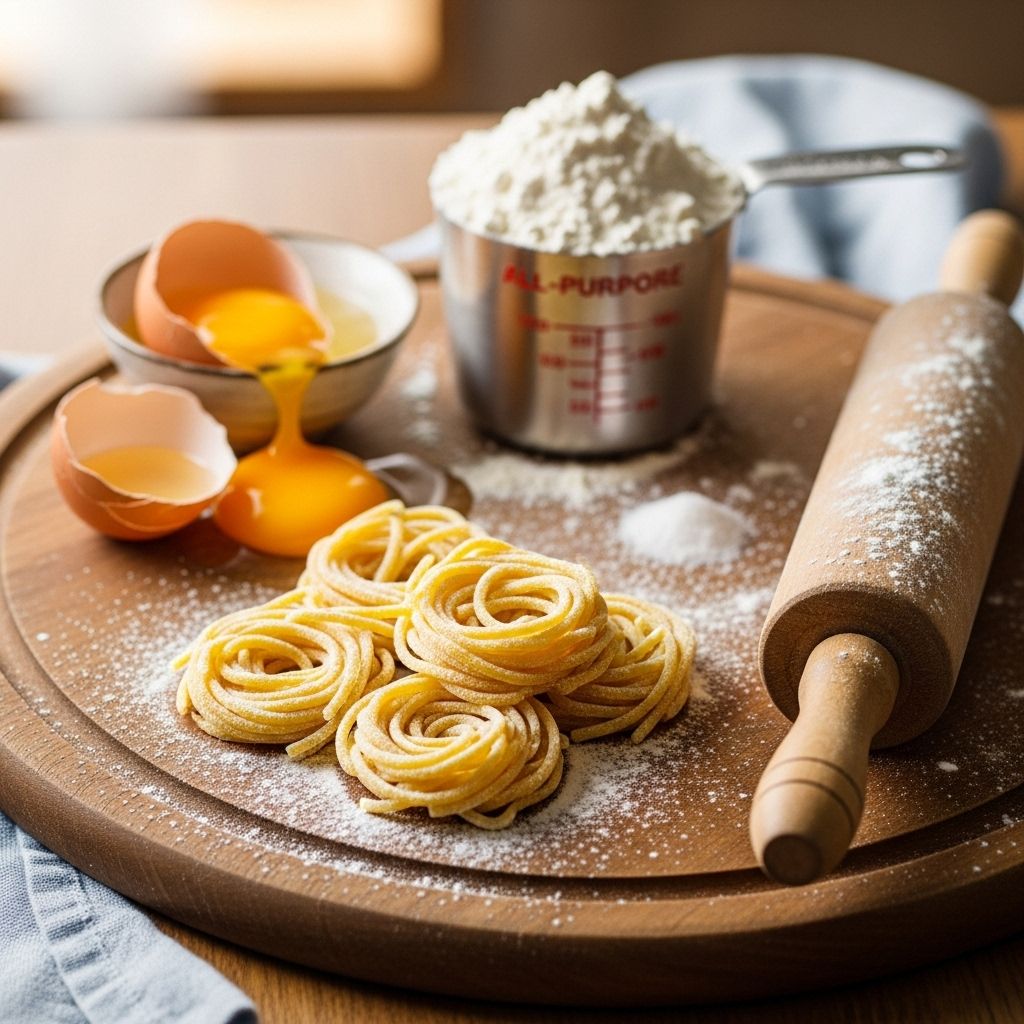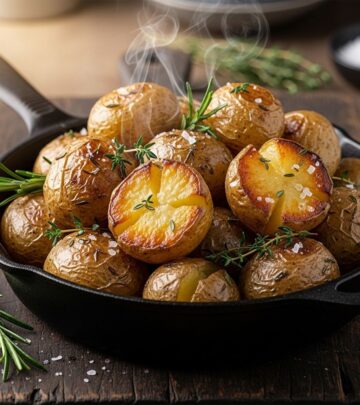Homemade Egg Noodles Recipe: 5 Easy Steps For Fresh Flavor
Master the art of making tender, old-fashioned egg noodles at home with just five pantry ingredients.

Image: HearthJunction Design Team
Easy Homemade Egg Noodles
Homemade egg noodles are a timeless kitchen staple, loved for their tender texture and rustic appeal. Whether used in comforting soups, served alongside hearty stews, or served as a simple side to soak up rich gravies, these noodles bring a taste of tradition to every meal. With just five basic ingredients and a straightforward process, making egg noodles from scratch is easier than you might think—and the results are unmatched by anything store-bought.
Why Make Egg Noodles at Home?
- Simple ingredients: Only pantry staples required
- Customizable: Adjust thickness and shape to your preference
- Fresh flavor: Superior texture and taste compared to packaged noodles
- Versatile: Perfect for soups, casseroles, or as a side dish
Ingredients
This classic egg noodle recipe calls for just five essentials:
- 2 cups all-purpose flour (plus more for dusting)
- 2 large eggs
- 1/2 teaspoon salt
- 1/2 cup milk
- 1 tablespoon butter
These ingredients form a rich, tender dough that cooks up perfectly every time.
Step-by-Step Instructions
Follow these easy steps for homemade egg noodles:
- Mix the Dry Ingredients:
- In a large bowl, combine the flour and salt.
- Blend Wet Ingredients:
- In a separate bowl, lightly beat the eggs. Stir in the milk and melted butter until well combined.
- Make the Dough:
- Pour the wet mixture into the flour and salt. Stir until a dough begins to form.
- Knead the dough on a lightly floured surface until smooth and elastic, about 5 minutes.
- Roll Out the Dough:
- Divide the dough in half for easier rolling. On a floured surface, roll each half into a thin sheet—about 1/8 inch thick for classic noodles.
- Cut the Noodles:
- Using a sharp knife or pizza cutter, slice the dough into strips to your desired noodle width. Keep them around 1/4 inch wide for traditional egg noodles.
- Dry or Cook:
- If you prefer, let the noodles air-dry on a rack or floured towel for 30 minutes to 2 hours before cooking. This helps preserve their shape when boiling.
- Cook the Noodles:
- Bring a large pot of salted water to a boil. Drop in the noodles and cook for 2–4 minutes, until just tender to the bite. Fresh noodles cook much faster than dried or packaged varieties.
- Drain well and serve hot.
Cooking Tip
For extra flavor, cook the noodles directly in broth instead of water—especially if using them in soups or casseroles.
Serving Suggestions
Egg noodles are a versatile canvas for a variety of dishes. Here are some popular ways to enjoy them:
- Beef Stroganoff: Classic creamy sauce served over wide egg noodles.
- Chicken Noodle Soup: Add freshly cooked noodles to a rich chicken broth with vegetables.
- Baked Casseroles: Layer noodles in cheese or veggie bakes for a comforting meal.
- As a Side: Toss with butter, fresh herbs, or a drizzle of olive oil for a simple accompaniment to roasted meats and gravies.
Expert Tips for Perfect Noodles
- Rest the dough before rolling to allow the gluten to relax, making it easier to roll thin.
- Dust generously with flour during rolling and cutting to prevent sticking.
- For chewier noodles, roll thicker; for tender, delicate noodles, roll thinner.
- Air-dry noodles for a firmer texture and better storage.
- Customize by adding chopped fresh herbs or cracked pepper to the dough.
Storing Homemade Egg Noodles
- Short-Term: Fresh noodles can be stored in an airtight container in the refrigerator for up to 2 days before cooking.
- Long-Term: To store longer, let the noodles air-dry completely, then transfer to a sealed container. They will keep for up to 1 month in a cool, dry place.
- Freezing: Arrange uncooked noodles in a single layer on a baking sheet, freeze until solid, then store in zip-top bags in the freezer for up to 3 months. Cook directly from frozen.
Recipe Variations
| Variation | Description |
|---|---|
| Whole Wheat Egg Noodles | Replace up to half the all-purpose flour with whole wheat flour for a nuttier flavor and more fiber. |
| Spinach Noodles | Puree cooked, squeezed-dry spinach and substitute for a portion of the liquid for a colorful, veggie-packed noodle. |
| Herbed Noodles | Add 1–2 tablespoons of finely chopped fresh herbs like parsley, chives, or dill to the dough for added aroma and freshness. |
| Gluten-Free Noodles | Use a gluten-free all-purpose flour blend; results may vary and additional binding may be needed. |
Frequently Asked Questions (FAQs)
Q: Can I make egg noodles ahead of time?
A: Yes! Prepare the noodles and let them dry for a few hours, then store them in an airtight container in the fridge for up to 2 days, or freeze for long-term use.
Q: How do I prevent the noodles from sticking together?
A: Dust noodles well with flour as you roll and cut them. Stir gently during cooking and don’t overcrowd the pot.
Q: Can I use a stand mixer or pasta machine?
A: Absolutely. Use a dough hook to knead the dough and a pasta roller to get consistently thin sheets.
Q: What’s the best way to cut the noodles evenly?
A: After rolling out the dough, loosely roll it up and slice crosswise to achieve uniform strips, then unroll and separate.
Q: Can I double or halve this recipe?
A: Yes, the recipe scales up or down easily. Adjust flour gradually as needed, since egg sizes can vary.
Homemade vs. Store-Bought Egg Noodles
| Homemade Egg Noodles | Store-Bought Egg Noodles |
|---|---|
| Fresh flavor and texture | Convenient but often less flavorful |
| Customizable size and thickness | Uniform but limited shape options |
| Shorter cooking time | Requires longer boiling |
| No preservatives or additives | May contain stabilizers and salt |
| Can be made in bulk and frozen | Ready to use straight from the package |
Expert Notes
Homemade egg noodles have deep culinary roots in many cultures and cuisines. While the process is simple, a few details make all the difference. Kneading until smooth, resting the dough, keeping everything well-floured, and monitoring cooking time are the keys to success. Once you master the technique, you can enjoy fresh pasta anytime—no pasta maker required.
Praise from Home Cooks
“These noodles were just like my grandmother made—soft, rich, and perfect for chicken soup!”
“Simple ingredients and amazing results. I’ll never buy packaged noodles again.”
Conclusion
Homemade egg noodles are a simple pleasure that bring comfort and nostalgia to any table. By combining a handful of ingredients with a little time and care, you can create tender, delicious noodles that elevate a wide range of dishes. Try your hand at this timeless recipe and discover why homemade always tastes better!
References
Read full bio of Srija Burman












